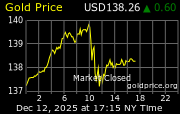
The gold price climbed $39.66 to $1,857.32 per ounce Thursday afternoon, rebounding from yesterday’s sharp sell-off. The SPDR Gold Trust (GLD), a proxy for the gold price and the world’s largest gold ETF, advanced $3.77, or 2.1%, to $180.85 per share. COMEX gold futures, per the December 2011 contract, reached an intra-day high of $1,868.70 per ounce and maintained the majority of their gains as trading progressed.
Despite the volatility and series of large declines, the gold price recently surpassed the price of platinum for the first time since 2008. On Thursday, platinum advanced $25.30 to $1,854.00 per ounce, however, gold’s outperformance continued, sending the platinum/gold ratio below 1.0 once again. Gold’s superior performance relative to platinum has been largely related to ongoing risks of renewed recessions in the U.S. and Europe.
UBS was the latest investment bank to raise its gold forecast, based on a multitude of factors likely to push the yellow metal to further new all-time highs.
UBS lifted its 2012 average gold estimate to $2,075, a 50.4% increase over its prior target of $1,380 per ounce. In 2013, UBS expects gold to average $1,780 per ounce, 48.3% above its prior estimate of $1,200 per ounce.
In its report to clients, analysts led by Edel Tully wrote that “Our core view is that ongoing global macroeconomic disappointments, the inevitability of further negative turns in the European sovereign debt crisis, and low business, consumer and investor confidence will lead to gold being increasingly used as the line of defence against negative market outcomes. With the pool of competing asset alternatives sparse, ‘new’ money will flow into the gold market over the months ahead and into 2012, which has significant price implications.”
UBS went on to say that “The maintenance of U.S. rates close to zero means that gold is not in competition with assets that offer yield. Economic growth expectations globally are declining, high debt burdens in Europe will continue to hamper growth, and the risk of a U.S. recession is rising. All of these factors are individually positive for gold. Taken together, they are a potentially explosive cocktail.”



































